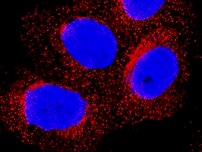Human TFEB Antibody Summary
Pro384-Ala446
Accession # P19484
Applications
Please Note: Optimal dilutions should be determined by each laboratory for each application. General Protocols are available in the Technical Information section on our website.
Scientific Data
 View Larger
View Larger
Detection of Human TFEB by Western Blot. Western blot shows lysates of Raji human Burkitt's lymphoma cell line. PVDF membrane was probed with 2 µg/mL of Mouse Anti-Human TFEB Monoclonal Antibody (Catalog # MAB9170) followed by HRP-conjugated Anti-Mouse IgG Secondary Antibody (Catalog # HAF018). A specific band was detected for TFEB at approximately 70 kDa (as indicated). This experiment was conducted under reducing conditions and using Immunoblot Buffer Group 1.
 View Larger
View Larger
TFEB in A549 Human Cell Line. TFEB was detected in immersion fixed A549 human lung carcinoma cell line using Mouse Anti-Human TFEB Monoclonal Antibody (Catalog # MAB9170) at 3 µg/mL for 3 hours at room temperature. Cells were stained using the NorthernLights™ 557-conjugated Anti-Mouse IgG Secondary Antibody (red; Catalog # NL007) and counterstained with DAPI (blue). Specific staining was localized to cytoplasm. View our protocol for Fluorescent ICC Staining of Cells on Coverslips.
Reconstitution Calculator
Preparation and Storage
- 12 months from date of receipt, -20 to -70 °C as supplied.
- 1 month, 2 to 8 °C under sterile conditions after reconstitution.
- 6 months, -20 to -70 °C under sterile conditions after reconstitution.
Background: TFEB
Transcription Factor EB/TFEB binds E-box (5'-CANNTG-3') where it plays a role in T cell activation through expression of CD40L and CLEAR-box (5'-GTCACGTGAC-3') sequences where it promotes expression of lysosomal genes essential for regulation of autophagy. TFEB is localized to the cytoplasm and translocates to the nucleus under aberrant lysosomal storage conditions. Phosphorylation of S211 in an MTORC1 dependent manner sequesters TFEB in the cytoplasm through association with 14-3-3 family proteins. Inhibition of MTORC1 causes dissociation from this complex and rapid accumulation in the nucleus.
Product Datasheets
Citations for Human TFEB Antibody
R&D Systems personnel manually curate a database that contains references using R&D Systems products. The data collected includes not only links to publications in PubMed, but also provides information about sample types, species, and experimental conditions.
3
Citations: Showing 1 - 3
Filter your results:
Filter by:
-
Formononetin alleviates hepatic steatosis by facilitating TFEB-mediated lysosome biogenesis and lipophagy
Authors: Y Wang, H Zhao, X Li, Q Wang, M Yan, H Zhang, T Zhao, N Zhang, P Zhang, L Peng, P Li
J. Nutr. Biochem., 2019-07-25;73(0):108214.
Species: Human
Sample Types: Whole Cells
Applications: ICC -
IFN? Impairs Autophagic Degradation of mtDNA Promoting Autoreactivity of SLE Monocytes in a STING-Dependent Fashion
Authors: K Gkirtziman, E Kabrani, D Nikoleri, A Polyzos, A Blanas, P Sidiropoul, A Makrigiann, G Bertsias, DT Boumpas, P Verginis
Cell Rep, 2018-10-23;25(4):921-933.e5.
Species: Human
Sample Types: Whole Cells
Applications: ICC -
Liraglutide Alleviates Hepatic Steatosis by Activating the TFEB-Regulated Autophagy-Lysosomal Pathway
Authors: Yunyun Fang, Linlin Ji, Chaoyu Zhu, Yuanyuan Xiao, Jingjing Zhang, Junxi Lu et al.
Frontiers in Cell and Developmental Biology
FAQs
No product specific FAQs exist for this product, however you may
View all Antibody FAQsReviews for Human TFEB Antibody
Average Rating: 5 (Based on 1 Review)
Have you used Human TFEB Antibody?
Submit a review and receive an Amazon gift card.
$25/€18/£15/$25CAN/¥75 Yuan/¥2500 Yen for a review with an image
$10/€7/£6/$10 CAD/¥70 Yuan/¥1110 Yen for a review without an image
Filter by:


